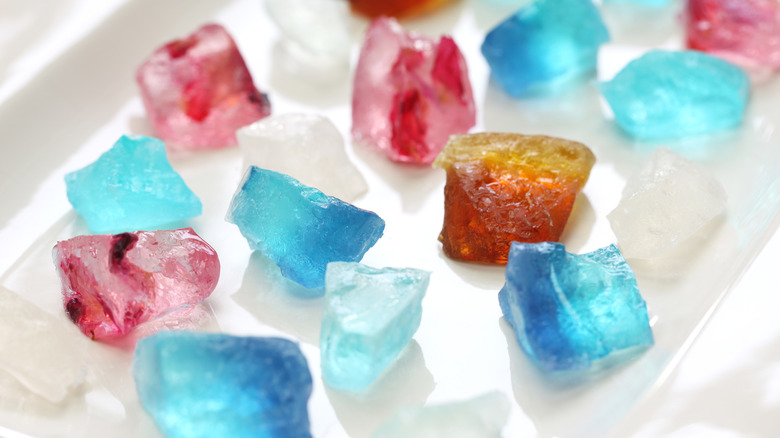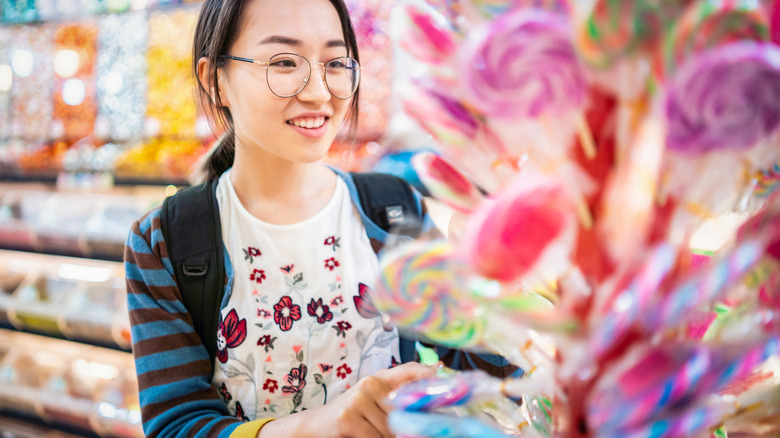Kohakutou, The Sweet And Sparkly Edible Crystal Candies Redefining Crunch
You're having a typical day of doom-scrolling through social media when you see people biting into shiny crystals. To your surprise, each chomp results not in broken teeth but in a satisfying crunch.
Social media has given birth to numerous food trends such as ASMR and mukbangs, and one that's recently captured the internet's collective fascination is the sparkling world of edible crystal candies known as kohakutou. These shimmering treats originate from Japan (the term means "amber sugar" in Japanese), likely dating back to the Edo period, and were invented by Tarozaemon Minoya. Today, kohakutou intrigues a global audience thanks to its vibrant colors, flavors, shapes, and captivating crunchiness. Through the ages, its popularity has been echoed across Asia, where different countries have different spins – in Korea, it's called hobakdang. In Thailand, it's known as kanom woon grop. In Vietnam, mứt rau câu and Indonesia, agar agar kering.
Each version carries these signature elements: a beautiful crystalline appearance, an appealing crunchy shell, and a soft, sweet jelly core.
The rise of edible crystals and gems is powered by social media and innovative brands
In the U.S. and across social media, kohakutou are known as "edible crystals" or "edible gems." These days, they're easy to find, especially online. Brands like the Korean-inspired Kandy Seoul, founded by Penny Park; the Vietnamese-inspired Silky Gem by Gia Huynh; and the Japanese-inspired Misaky Tokyo by Alissa Miky sell their own unique versions of these edible crystal candies. All three brands also share the proud identity of being AANHPI (Asian American, Native Hawaiian, and Pacific Islander) owned and female-founded.
These trailblazers have successfully introduced this traditional candy to a broad audience, making it accessible and highly desirable. Due to high demand — and the fact that these sweets are usually handcrafted — you can wait up to a few weeks for the crunchy candies to arrive at your door. For instance, Kandy Seoul's current processing time is up to 14 business days, and this does not include holidays and weekends.
You can also find kohakutou across Etsy, where various creators craft and sell their own versions of these edible gems. Flavors can come tame and light (like horchata, lemon, apple, pandan, or berries) or wild, with varieties that can be spicier than hot wings. The success of these brands and creators underscores kohakutou's global appeal.
Making edible crystals at home is easy but takes time and patience
Now if you're wondering how to make kohakutou at home, we've got you covered. This candy is vegan and gluten-free, and the magic begins with water, sugar, and agar-agar, a vegan gelatin substitute made from seaweed. Almost any flavors and colors can be added, and all the ingredients are combined and cooked together, like jello, allowed to cool and set, and then shaped, molded, or cut into different crystal-like forms, usually with a paring knife.
Making kohakutou is not necessarily a good fit for the impatient, as it takes a few days for the candy to earn its famous crunchy exterior, which traditionally comes from days of sun-drying. If you really can't wait, you could always try the candy once set, but it will likely not be as satisfying without the crunchiness.
The creative possibilities are practically endless when it comes to homemade kohakutou. Layers of different colors and flavors can be created, while toppings like sprinkles, edible gold, flower petals, or swirling colors can add extra magic to these crystalline candies. And all those who make kohakutou at home can proudly call themselves artisans.
With great aesthetics and a satisfying crunch, kohakutou transcends age groups and geography, making it a sweet and fun treat for both kids and the young at heart.


